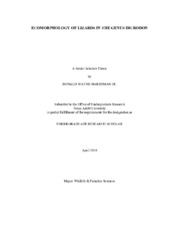| dc.contributor.advisor | Fitzgerald, Lee A | |
| dc.creator | Hardeman, Donald W | |
| dc.date.accessioned | 2013-06-04T16:10:24Z | |
| dc.date.available | 2013-06-04T16:10:24Z | |
| dc.date.created | 2010-05 | |
| dc.date.issued | 2012-07-11 | |
| dc.date.submitted | May 2010 | |
| dc.identifier.uri | https://hdl.handle.net/1969.1/ETD-TAMU-2010-05-8161 | |
| dc.identifier.uri | https://hdl.handle.net/1969.1/148756 | |
| dc.description.abstract | Ecological theory suggests morphology should be linked to foraging mode and strategy. This study was conducted to determine the possible relationship between morphology and diet of a monophyletic group of lizards in the genus Dicrodon. Field anecdotes indicate two of the three species are herbivorous and arboreal, while the third is an insectivorous species found in the costal deserts of Peru. We tested for differences in morphology among the three species using an Analysis of Covariance, while dietary data was tabulated and frequency of occurrence and percent composition was calculated for stomach contents. Our results confirmed D. heterolepis is in fact an insectivorous species with the potential to be a generalist, whereas, D. holmbergi and D. guttulatum are herbivorous. Theory predicts morphological differences should exist in correspondence with major dietary modes. Our morphological analyses showed the herbivorous species were very similar in body plan, and the insectivore had relatively larger head and front limbs. | en |
| dc.format.mimetype | application/pdf | |
| dc.subject | Ecomorphology | en |
| dc.subject | lizards | en |
| dc.subject | Teiidae | en |
| dc.subject | Dicrodon | en |
| dc.subject | morphology | en |
| dc.title | Ecomorphology of Lizards in the Genus Dicrodon | en |
| dc.type | Thesis | en |
| thesis.degree.department | Wildlife and Fisheries Sciences | en |
| thesis.degree.discipline | Wildlife and Fisheries Sciences | en |
| thesis.degree.grantor | Honors and Undergraduate Research | en |
| thesis.degree.name | Bachelor of Science | en |
| dc.type.material | text | en |
| dc.date.updated | 2013-06-04T16:10:24Z | |


